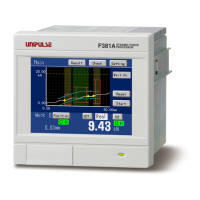59
4 SETTINGS AND CALIBRATIONS
59
SETTINGS AND CALIBRATIONS
Chapter
4
How to detect Relative Maximum and Relative Minimum
First, when Difference X between Point A and Point B exceeds
Detection Load Difference, Point A is judged to be Relative
Maximum, and Point B is judged to be Relative Minimum.
When Relative Maximum A and Relative Minimum B are
detected, and Difference X between them exceeds Detection Rate
(1/4 to 4 Times), at each point (Point Q if the Rate is 4 Times for
example), A and B are displayed and held when the settings of
“Use Hold” are Relative Maximum and Relative Minimum,
respectively.
In the case where Relative Maximum and Relative Minimum
appear more than once on a waveform, Relative Maximum and
Relative Minimum are held after counting the number of times set
under “Detection Ordinal.” For example, if the setting is “2,” A’
and B’ are held as Relative Maximum and Relative Minimum,
respectively.
If the value of Detection Load Difference is too small, noise in the
waveform as shown at the right may be regarded as Relative
Maximum and Relative Minimum so that correct values may not
be able to be held. Set an appropriate value by checking the input
waveform on the screen.
If Inflection Point is selected to Hold, the following setting items are
displayed.
- Detection Interval AB
Set Detection Interval A and Detection Interval B.
Setting range (The range is the same for A and B.)
(1 to 999 × Measurement Length/2000)
Main screen→Setting→Work Setting→Hold Setting→Use Hold→Inflect.
→Interval AB
① Set the inflection point you want to take. Touch the graph area or
specify with the cursor keys, and then press .
True relative
True relative
maximum
minimum
Relative
Relative
maximum
minimum

